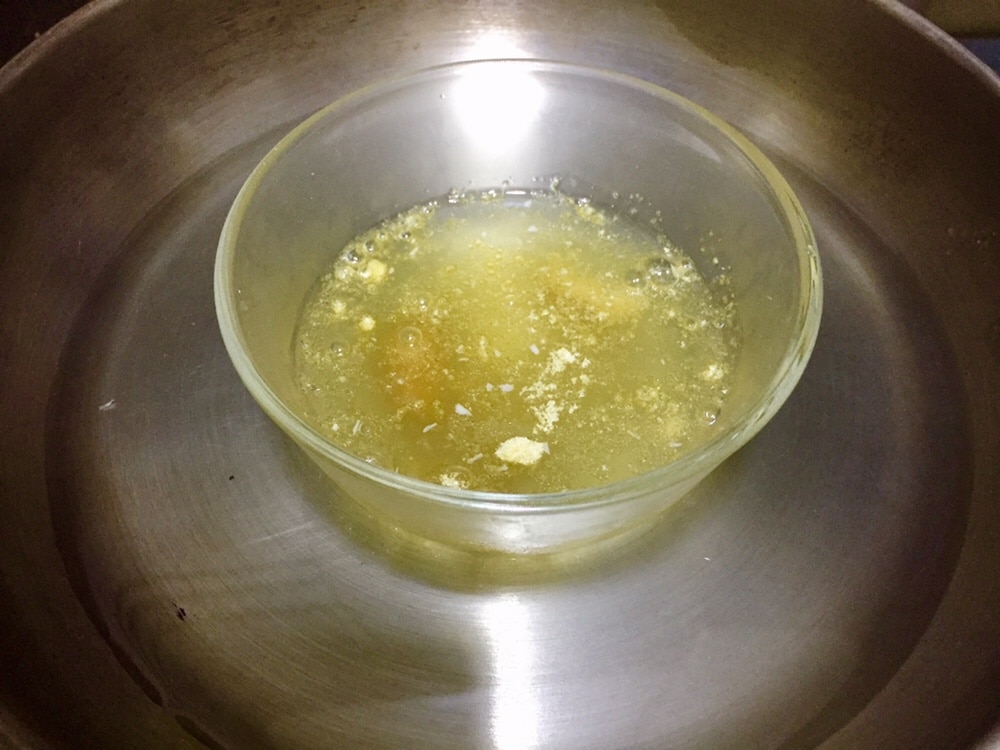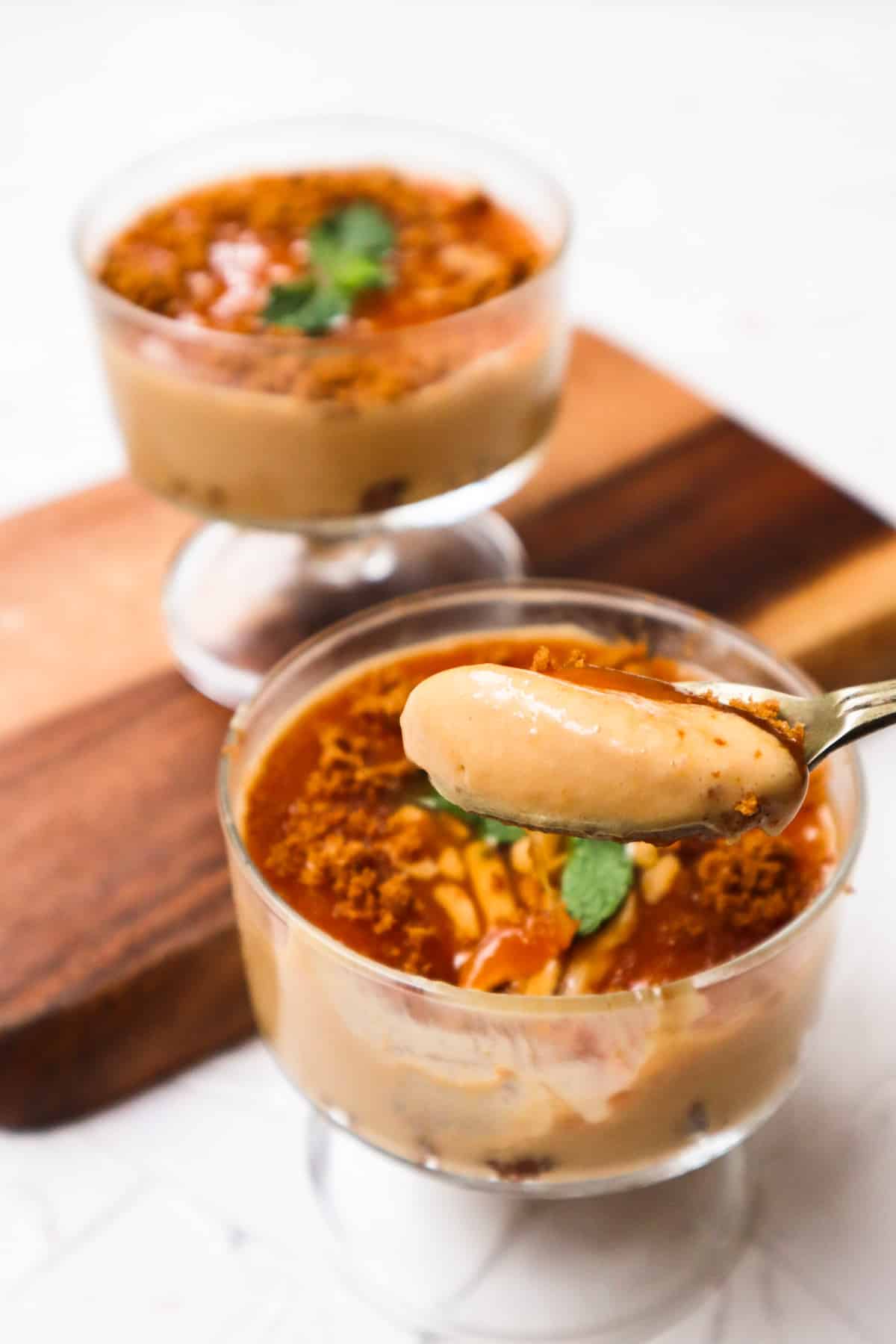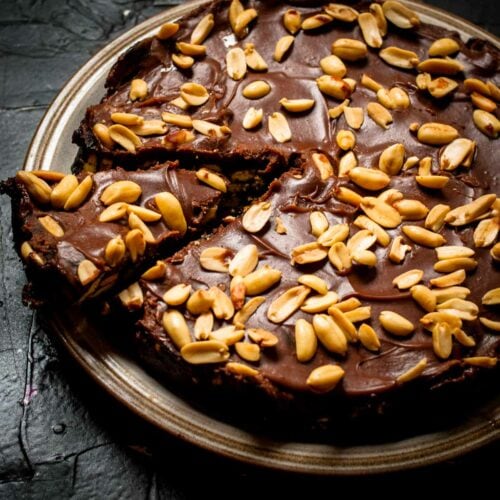I have a confession to make! I hated the recipes that called for gelatin. I would rather use lemon-flavored regular jelly in a recipe instead of gelatin. And my mould would turn out perfectly every time with jelly but not with gelatin.
Jump to:
Why isn't my gelatin setting?
Setting a souffle or salad with gelatin was always an uncertain thing for me. Sometimes, it would set just right, and sometimes it won't. After many good and bad experiences ( all dreaded once), I learned my lesson and I wish to share my lesson here.

What is gelatin?
Gelatin is simple stuff made from animal parts; skin, hooves, and bones. The science behind gelatin is that it's a protein that sets upon cooling and liquefies upon heating. Have you noticed, the beef/chicken broth made from bones also sets like jelly when kept in fridge?
Uses
Gelatin is 70% protein that forms a matrix of chain between gelatin molecules in the dessert or salad or jelly that holds the liquid. It gives a dessert, salad or pudding a proper shape that can be unmolded.

What is bloomed gelatin?
The powder gelatin is made up of transparent yellowish crystal. You can't use it in a recipe directly. You need to dissolve the crystals in any liquid (preferably water, milk would take more time) completely. The process is often referred to as the blooming of gelatin by chefs. If you bloomed gelatin correctly and your ratio of liquid to gelatin is correct, your dish should be set easily.
If your dish won't set?
No need to worry. Heat the liquid. The heating will make gelatin crystals bloom well. And you can fix the dish that is not set by heating it. You can also mix more bloomed gelatin while heating if needed.
There is one disadvantage of heating. Something delicate like souffle would go flat and lose its sponginess. The air trapped by beating will be released. However, it will set and will be soft but not spongy and light.

You can heat on the stove or microwave, but keep stirring frequently at short intervals. You just need to heat and not boil it. Keep the heating process to be a stage before boiling point. Since gelatin is a protein that denatures overheating and losses its efficiency.
Why does store-bought jello set easily?
Remember, in the beginning, I mentioned that using a regular jelly (don't confuse it with a quick set) in dessert instead of gelatin always got me the desired result. Here's why it is so.
Sugar and gelatin both love water and compete for it. So the right amount of sugar will give you a shorter chain and softer dessert. Ideally, you need to mix sugar with gelatin before adding water or other liquid. Since the jelly always has sugar mixed with gelatin prior to cooking, it always works best.
So the takeaway here is that when gelatin is used in presence of enough sugar, it is softer and jelly-like.
Best way to use gelatin for desired results.
Since I use gelatin crystals in most of my desserts and here's the tip I learned over years.
Gelatin crystals need to be hydrated in lukewarm water or other warm liquids (like milk or juices) so the edges of the crystal absorb water. Keep stirring at regular intervals until dissolved.
If you mix gelatin in hot liquid directly, the water will not reach the center of crystal and the crystals will stick together. So beware of it, that will not let your gelatin bloom.
How to bloom gelatin?

Over a hot water bath, keep a bowl of gelatin. (Just boil water in a pan and keep heatproof bowl in it, remove from heat.)

Add lukewarm liquid to the gelatin crystal. It may be water, juice, or milk. Mix at regular intervals until all crystals completely dissolve, about 2 minutes. No gelatin crystal should be lingering around the vessel or spoon, all should be dissolved.

Keep the bloomed gelatin in a hot water bath until needed in your recipe. If gelatin solidifies heat again on a slow flame until melted without boiling.
Then add bloomed gelatin as the recipe calls for it. And the mould should set easily.
The simple ratio for gelatin powder to liquid
Mix 1 tablespoon of gelatin with 2 cups (500 ml) of liquid. If you use 1 tablespoon of gelatin in three cups of liquid, you'll have softer jelly that can be served in a dish without un-moulding.
- If you use less gelatin your end result will be softer. And if you use too much gelatin your end result will be rubbery jelly.
- Similarly, the longer gelatin sits in the fridge, the rubbery its texture.

Things to know about gelatin
- Gelatin doesn't work well in presence of a few fruit juices like pineapple. But if the fruit or juice is cooked before adding it to a recipe, then it won't affect gelatin's efficiency. Because the enzymes that hinder the formation of gelatin chains are hydrolyzed upon heating.
- Gelatin leaves to powder conversion: 4 sheets gelatin = 1 tablespoon powdered gelatin
- Gelatin is usually the last step in any recipe after which you transfer liquid to the mould.
- Too much stirring after adding gelatin can also break the interchains that form as gelatin sets and hence hinder the setting process.
FAQ
After adding gelatin to the recipe mix well so gelatin molecules are spread all over the dish. Then let it sit in a cool place or fridge to set for at least 4-6 hours. Do not mix in between.
Add lukewarm water to the gelatin crystal. Mix at regular intervals until all crystals completely dissolve, about 2 minutes. No gelatin crystal should be lingering around the vessel or spoon, all should be dissolved.
Keep the bloomed gelatin in a hot water bath until needed in your recipe. If gelatin solidifies heat again on a slow flame until melted without boiling.
Heat the liquid gradually without boiling it. The heating will make gelatin crystals bloom well. And you can fix the dish that is not set by heating it. You can also mix more bloomed gelatin while heating if needed. But heating can spoil a few delicate foods like fruits and deflate the cream. So do it with precaution.
If gelatin gets lumpy, it meant that the gelatin was not mixed properly. You try heating it gradually without bringing it to boiling point. Try melting the gelatin and mixing it evenly. But the result is doubtful and depends on the dish itself.
Hungry for more? Try these desserts!









Jennifer says
How come many recipes call for gelatin to be bloomed in ice water or cold water instead of hot?
Irum says
I think I added lemon that s why my jam doesn’t set?
Mariam Sodawater says
Hi Irum, just cook the jam until it reaches the setting point. It should be set I assume. Which jam were you making?
Lee says
Hi, is it possible to bloom gelatin, melt it over hot water bath and add to a yogurt cake batter that consist largely of yogurt, some yolks and blueberry compote and bit of flour. Then bake the mixed batter with gelatin in oven for 1hr and chill in fridge overnight. Will it set?
Mariam Sodawater says
Hi, thanks for the interesting and detailed question. Gelatin is a protein. So if you subject it to high temperatures like baking for long. It will lose its rigidity. So your cake won't be firm if it has too much water. But gelatin doesn't lose its viscosity (ability to add thickness) on heating. That is why gelatin is useful in making sauces that are heated at high temperatures. Because you have eggs in the yogurt cake which should make it firm as it happens in the egg pudding. You can give this a try. For eggs in pudding usual ratio for a thin batter-like consistency is one egg per one cup of batter. I hope this helps.
Jude says
Thank you so much for sharing your expertise around the science of making jelly deserts from Gelatin.
I wish I had read it first. I’m sure my rubbery desert will taste just fine and next time will have the right texture too
Mariam Sodawater says
I appreciate your feedback! Most people come to this post in distress and couldn't leave a comment. It is good to hear that you find this post useful. It will taste fine but it will get more rubbery as it sits for more days.
Dave says
I am a complete armature and am experimenting with making Gelatin molds using unflavored Gelatin (Superclear). I made up a “batch” with banana, blueberry and lemon juice. I used monk fruit instead of sugar. I “bloomed” two tablespoons of gelatin powder to 4 cups of water by first putting the dry gelatin in cool water and adding it to 2 cups of hot but not boiling water. It did not gel after hours. I then added more gelatin powder, still not gelling. How do I fix this??
Dave says
I am a complete armature and am experimenting with making Gelatin molds using unflavored Gelatin (Superclear). I made up a "batch" with banana, blueberry and lemon juice. I used monk fruit instead of sugar. I "bloomed" two tablespoons of gelatin powder to 4 cups of water by first putting the dry gelatin in cool water and adding it to 2 cups of hot but not boiling water. It did not gel after hours. I then added more gelatin powder, still not gelling. How do I fix this??
Recipe 52 says
Is your gelatin fresh? Old gelatin from pantry might not work well.
dave says
It is less than a year old.
Recipe 52 says
This could be the issue, always use fresh Gelatin. As these things are kept in pantry around warm humid kitchen.
You can try setting fresh gelatin. Your make something else out of it.Hope this helps.
dave says
It is less than a year old.
Can I take off most of the liquid and heat it, add more bloomed gelatin and retry? Or should I heat the fruit also? I'm also curious if the non sugar sweetener is part of the problem
Recipe 52 says
Gelatin requires sugar to gel. It can use sugar from fruit juice too. If you are using fruit chunks then it might not get enough sugar to gel.
Now, to be honest you can try adding little sugar to set it. If the old gelatin package was open earlier and not sealed you must change it too. If it was sealed you can skip changing it. Do not add to much gelatin as once it start setting it will get rubbery.
Reheating fruit is not necessary.
Good luck. I really wish it helps and you can save your food.